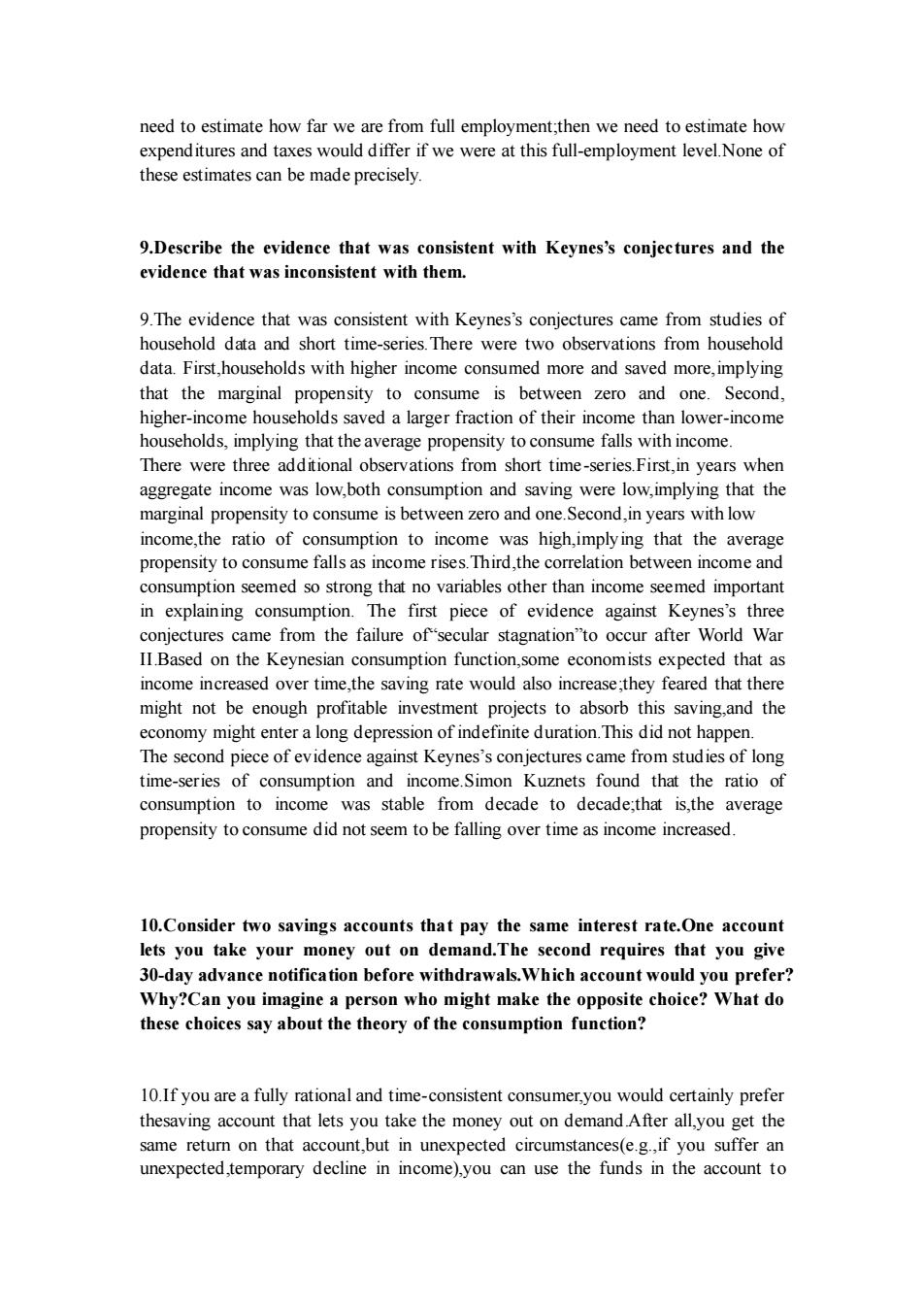正在加载图片...

need to estimate how far we are from full employment then we need to estimate how and taxes would fer if we were at this full-employment leve Noe these estimates can be made precisely 9.Describe the evidence that was consistent with Keynes's conjectures and the evidence that was inconsistent with them 9.The evidence that was consistent with Keynes's conjectures came from studies of household data and short time-series.There were two observations from household data.First,households with higher income consumed more and saved more.implying that the marginal propensity to consume is betwee zero and one higher-income h eholds saved a larger fraction of their inc ne tha n lower-Income households,implying that the average propensity to consume falls with income. There were three additional observations from short time-series.First,in years when aggregate income was low,both consumption and saving were low,implying that the arginal propensity toconsume is,in ye swith low income,the ratio of cor sumption to incon wa high,implying that the averag propensity to consume falls as income rises.Ihird,the correlation between income and consumption seemed so strong that no variables other than income seemed important in explaining consumption.The first piece of evidence against Keynes's three conjectures came from the failure of'secular stagnation"to occur after World War II.Base K mption funct expected that as income increased over time,the saving rate would also increase:they feared that there might not be enough profitable investment projects to absorb this saving and the economy might enter a long depression of indefinite duration.This did not happen. The second piece of evidence against Keynes's conjectures came from studies of long of cor and incor me.Simor ets fo und that the ratio of consumption to incom was stable decade to decad is,the propensity to consume did not seem to be falling over time as income increased 10.Consider two savings accounts that pay the same interest rate.One accoun lets you take your money out on demand.The second requires that yougve 30-day advance notification before withdrawals.Which account would you prefer? Why?Can you imagine a person who might make the opposite choice?What do these choices say about the theory of the consumption function? 10.If you are a fully rational and time-consistent consumer,you would certainly prefer thesaving account that lets you take the money out on demand After all,you get the same return on that account but in unexpected circumstances(e.g.if you suffer an unexpected,temporary decline in income).you can use the funds in the account toneed to estimate how far we are from full employment;then we need to estimate how expenditures and taxes would differ if we were at this full-employment level.None of these estimates can be made precisely. 9.Describe the evidence that was consistent with Keynes’s conjectures and the evidence that was inconsistent with them. 9.The evidence that was consistent with Keynes’s conjectures came from studies of household data and short time-series.There were two observations from household data. First,households with higher income consumed more and saved more,implying that the marginal propensity to consume is between zero and one. Second, higher-income households saved a larger fraction of their income than lower-income households, implying that the average propensity to consume falls with income. There were three additional observations from short time-series.First,in years when aggregate income was low,both consumption and saving were low,implying that the marginal propensity to consume is between zero and one.Second,in years with low income,the ratio of consumption to income was high,implying that the average propensity to consume falls as income rises.Third,the correlation between income and consumption seemed so strong that no variables other than income seemed important in explaining consumption. The first piece of evidence against Keynes’s three conjectures came from the failure of“secular stagnation”to occur after World War II.Based on the Keynesian consumption function,some economists expected that as income increased over time,the saving rate would also increase;they feared that there might not be enough profitable investment projects to absorb this saving,and the economy might enter a long depression of indefinite duration.This did not happen. The second piece of evidence against Keynes’s conjectures came from studies of long time-series of consumption and income.Simon Kuznets found that the ratio of consumption to income was stable from decade to decade;that is,the average propensity to consume did not seem to be falling over time as income increased. 10.Consider two savings accounts that pay the same interest rate.One account lets you take your money out on demand.The second requires that you give 30-day advance notification before withdrawals.Which account would you prefer? Why?Can you imagine a person who might make the opposite choice? What do these choices say about the theory of the consumption function? 10.If you are a fully rational and time-consistent consumer,you would certainly prefer thesaving account that lets you take the money out on demand.After all,you get the same return on that account,but in unexpected circumstances(e.g.,if you suffer an unexpected,temporary decline in income),you can use the funds in the account to